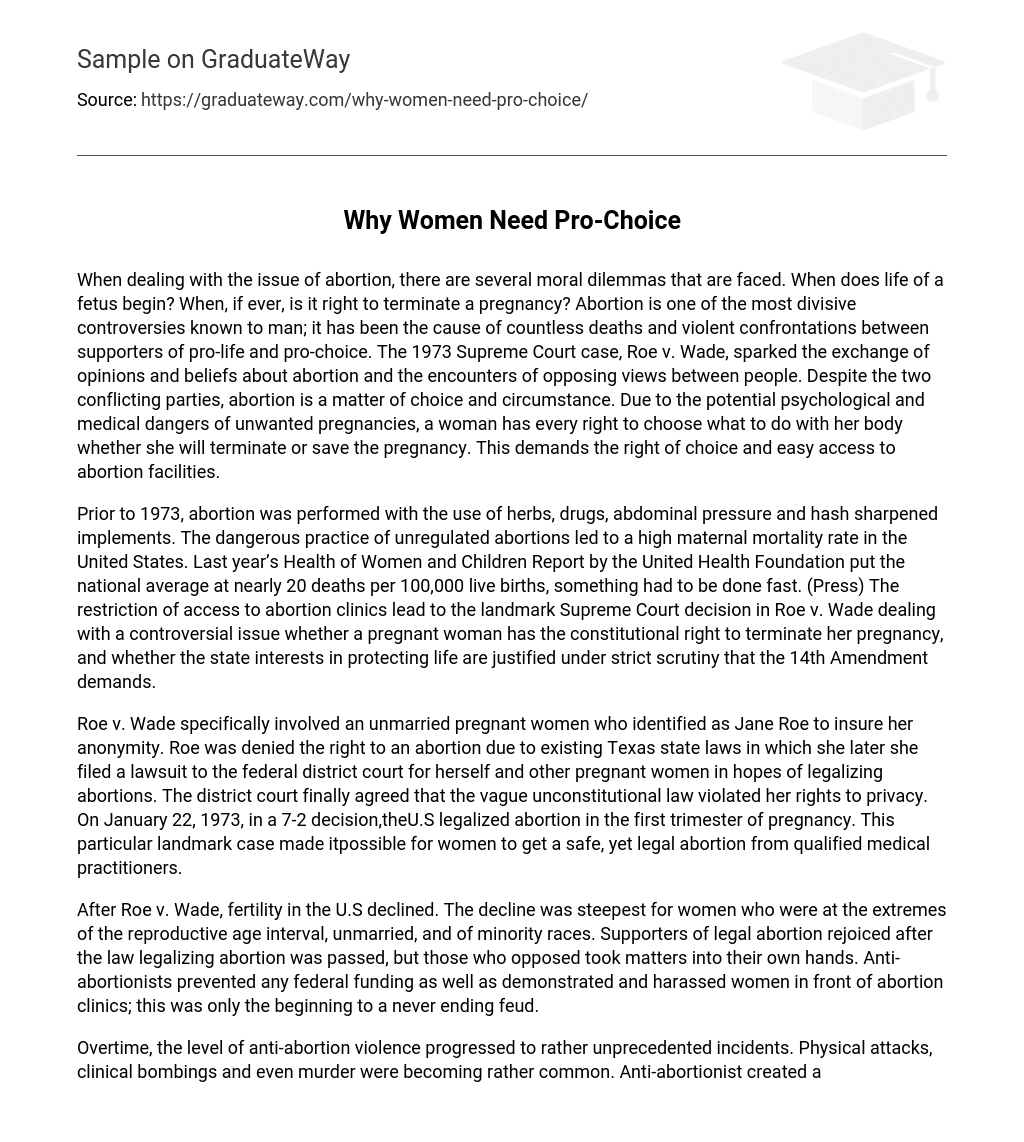When dealing with the issue of abortion, there are several moral dilemmas that are faced. When does life of a fetus begin? When, if ever, is it right to terminate a pregnancy? Abortion is one of the most divisive controversies known to man; it has been the cause of countless deaths and violent confrontations between supporters of pro-life and pro-choice. The 1973 Supreme Court case, Roe v. Wade, sparked the exchange of opinions and beliefs about abortion and the encounters of opposing views between people. Despite the two conflicting parties, abortion is a matter of choice and circumstance. Due to the potential psychological and medical dangers of unwanted pregnancies, a woman has every right to choose what to do with her body whether she will terminate or save the pregnancy. This demands the right of choice and easy access to abortion facilities.
Prior to 1973, abortion was performed with the use of herbs, drugs, abdominal pressure and hash sharpened implements. The dangerous practice of unregulated abortions led to a high maternal mortality rate in the United States. Last year’s Health of Women and Children Report by the United Health Foundation put the national average at nearly 20 deaths per 100,000 live births, something had to be done fast. (Press) The restriction of access to abortion clinics lead to the landmark Supreme Court decision in Roe v. Wade dealing with a controversial issue whether a pregnant woman has the constitutional right to terminate her pregnancy, and whether the state interests in protecting life are justified under strict scrutiny that the 14th Amendment demands.
Roe v. Wade specifically involved an unmarried pregnant women who identified as Jane Roe to insure her anonymity. Roe was denied the right to an abortion due to existing Texas state laws in which she later she filed a lawsuit to the federal district court for herself and other pregnant women in hopes of legalizing abortions. The district court finally agreed that the vague unconstitutional law violated her rights to privacy. On January 22, 1973, in a 7-2 decision,theU.S legalized abortion in the first trimester of pregnancy. This particular landmark case made itpossible for women to get a safe, yet legal abortion from qualified medical practitioners.
After Roe v. Wade, fertility in the U.S declined. The decline was steepest for women who were at the extremes of the reproductive age interval, unmarried, and of minority races. Supporters of legal abortion rejoiced after the law legalizing abortion was passed, but those who opposed took matters into their own hands. Anti-abortionists prevented any federal funding as well as demonstrated and harassed women in front of abortion clinics; this was only the beginning to a never ending feud.
Overtime, the level of anti-abortion violence progressed to rather unprecedented incidents. Physical attacks, clinical bombings and even murder were becoming rather common. Anti-abortionist created a very hostile environment for those in desperate need of seeking an abortion. With restrictive bills being passed by Congress, abortion clinics shut their doors at a record pace. Since 2011, at least 162 abortion providers have closed (Deprez). Nearly one fifth of these closings occurred in Texas, which passed sweeping, possibly unconstitutional restrictions in 2013 (NY Daily). Even places in blue states like California, access to nearby clinics are declining. There should be easy access to abortion clinics and no women should feel the decisions they make towards their own body should allow people to intentionally mistreat them.
There are hundreds of explanations as to why women need and seek abortions. Every year thousands of women become pregnant as a result of rape or incest, these are very traumatic crimes and it’s already difficult to cope. Since 1998, an estimated 17,700,000 women have been victims of rape. (Vagianos) Forcing victims to carry a physical reminder for nine straight months can cause a great amount of stress, often leading to mental health issues. Teenagers who become parents are most likely to suffer serious damage to their later future; they frequently drop out of school, rely on welfare funding to support themselves to raise their children. Teenage parents also tend to have limited or no careers later experiencing a high rate of depression and other health problems.
Single mothers sometimes may seek abortion simply because they can’t afford to take care of the soon to be child on their own. Growing up in a single-parent household has been associated with decreased verbal skills, abuse, and neglect. As the cost of living goes up the cost of raising a child has increased in the last year. According to a report from the Department of Agriculture, the cost of raising a child through the age of 17 has hit $233,610. Being responsible for a child takes time, effort, care, and money. Moreover, access to legal abortion is directly related to child well-being and some women simply can’t meet those needs and can’t afford to carry a child for nine months only to see it suffer.
There are over 7 billion human beings on Earth, and an estimated 43 million abortions a year. We have very restricted resources which might be depleting rapidly. Imagine those abortions hadn’t occurred with the present day population issue, so in a strange way abortion is useful. Legal abortion helps women in many ways; the medical, social, and economic benefits have been documented for decades (Grimes).
Abortion should stay legal and clinics should stay open. Though it’s a difficult decision, it cannot be deemed immoral if it could be the lifesaving situation for a woman. Women are determined enough to risk prison, sexual molestation, and even their existence. If a woman is willing to undergo harsh circumstances simply for an abortion, it clearly affects her more than those against it. Pro-choice defends and protects people. Pro-life supporters do not see the conditions, and motives from having abortions, they’re ignorant to the purpose why many women choose to make the choice they do.





